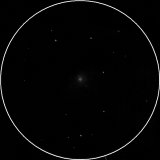
| MESSIER 79 |
|---|
RA: |
05h 25m 30s |
|
DEC: |
-24° 33' 00'' |
|
Type: |
Globular cluster |
|
NGC: |
1904 |
|
Magnitude: |
8.40 |
|
Surface brightness : |
12.00 |
|
Apparent dimensions : |
7.8'x7.8' |
|
Distance: |
42,100 ly |
|
Globular cluster M79 was found by Pierre Méchain on October 26, 1780, and reported his discovery to his friend and colleague, Charles Messier, who determined its position and included it in his catalog on December 17, 1780. It was first resolved into stars and recognized as a globular cluster by William Herschel in about 1784. M79 is a beautiful globular cluster at a quite unusual location in the sky: Most globulars are grouped around the Galactic center, but this is one of the few which are situated in the other hemisphere, i.e. it is beyond us for hypothetical observers in the central stellar bulge of our Milky Way galaxy. It is little over 40,000 light years from us, but about 60,000 light years from the galactic center. At this distance, M79's apparent diameter of 9.6 minutes of arc corresponds to a linear extension of about 118 light years. This cluster is slightly elliptical, extended at position angle 45 deg, and has only 7 known variables. It is receding from us at about 200 km/sec. Visually, in small telescope, M79 is not a rewarding target. 8" telescope can show some granulation near egdes but that is all. Telescope with 12" or more will show individual stars near edge. |
||
VEDRAN VRHOVAC© 2006.-2007. |
